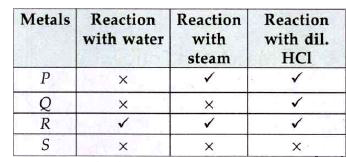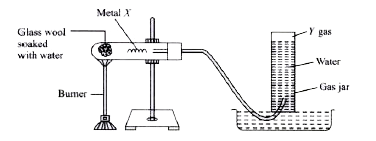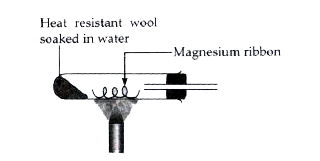Exercise (Match the following ) from MTG IIT JEE FOUNDATION METALS AND NON METALS for Class 10
| Class 10 | CHEMISTRY |
| Chapter | METALS AND NON METALS |
| MTG IIT JEE FOUNDATION | Exercise (Match the following ) |
| Medium | English |
| Academic Year | 2023-2024 |
Question 48
An element X (atomic number 12) reacts with another element Y (atomic number 17 ) to form a Compound Z. Which of the following statements are true regarding this compound ?
I. Molecular formula of Z is XY2
(II) It is soluble in water.
(III) X and Y are joined by sharing of electrons.
(IV) It would conduct electricity in the molten state. View SolutionQuestion 60
Assertion : Sulphide ores such as zinc blende (ZnS), copper pyrites (CuFeS2), galena (PbS) etc. are generally concentrated by froth floatation method.
Reason : The method is based on the fact that the surface of the sulphide ore is preferentially wetted by oils while that of gangue is preferably wetted by water.View SolutionQuestion 61
Assertion : Zinc is obtained from the roasted or calcined ore (ZnO) by heating with calculated quantity of coal or coke in a reverberatory furnace, when C reduces the metal oxide to free metal.
Reason : The process of extracting the metal by reduction of its oxide ore with carbon is called smelting. View SolutionQuestion 66
Metals occur in nature in the free as well as in the combined state. The less reactive metals are generally found in the free state. Most of the metals, however are found in the combined form as minerals. The minerals from which metals can be obtained on a commercial scale are called ores. In other words, the minerals from which metals can be extracted profitably are called ores. Thus, bauxite (Al2O3⋅2H2O)and clay (Al2O3.2SiO2.2H2O) are minerals of aluminium. However, it is bauxite that is chiefly used to obtain aluminium commercially. So, bauxite, and not clay, is an ore of aluminium.
Metal which occurs in native state is View SolutionQuestion 67
Metals occur in nature in the free as well as in the combined state. The less reactive metals are generally found in the free state. Most of the metals, however are found in the combined form as minerals. The minerals from which metals can be obtained on a commercial scale are called ores. In other words, the minerals from which metals can be extracted profitably are called ores. Thus, bauxite (Al2O3⋅2H2O)and clay (Al2O3.2SiO2.2H2O) are minerals of aluminium. However, it is bauxite that is chiefly used to obtain aluminium commercially. So, bauxite, and not clay, is an ore of aluminium.
Which of the following is a sulphide ore ? View SolutionQuestion 68
Metals occur in nature in the free as well as in the combined state. The less reactive metals are generally found in the free state. Most of the metals, however are found in the combined form as minerals. The minerals from which metals can be obtained on a commercial scale are called ores. In other words, the minerals from which metals can be extracted profitably are called ores. Thus, bauxite (Al2O3⋅2H2O)and clay (Al2O3.2SiO2.2H2O) are minerals of aluminium. However, it is bauxite that is chiefly used to obtain aluminium commercially. So, bauxite, and not clay, is an ore of aluminium.
Halide ore is View SolutionQuestion 69
Metals occur in nature in the free as well as in the combined state. The less reactive metals are generally found in the free state. Most of the metals, however are found in the combined form as minerals. The minerals from which metals can be obtained on a commercial scale are called ores. In other words, the minerals from which metals can be extracted profitably are called ores. Thus, bauxite (Al2O3⋅2H2O)and clay (Al2O3.2SiO2.2H2O) are minerals of aluminium. However, it is bauxite that is chiefly used to obtain aluminium commercially. So, bauxite, and not clay, is an ore of aluminium.
The most abundant metal on the earth's crust is View SolutionQuestion 70
The ore mined from the earth contains some unwanted substances called gangue. Enrichment of ore is done by various methods depending upon the nature of the impurities. Hydraulic washing is the process based on the difference in densities of ore and gangue particles. Froth floatation method is used for ores with different wetting properties of ore and gangue particles. On adding sulphide ore in a mixture of oil and water, the sulphide particles are wetted by oil and gangue particles are wetted by water. On passing air in this mixture, sulphide ore particles form light oily froth and reach the surface whereas gangue particles settle down at the bottom. Few ores are enriched by chemical processes.
WHich method is used for the purification of bauxite ore ? View SolutionQuestion 71
The ore mined from the earth contains some unwanted substances called gangue. Enrichment of ore is done by various methods depending upon the nature of the impurities. Hydraulic washing is the process based on the difference in densities of ore and gangue particles. Froth floatation method is used for ores with different wetting properties of ore and gangue particles. On adding sulphide ore in a mixture of oil and water, the sulphide particles are wetted by oil and gangue particles are wetted by water. On passing air in this mixture, sulphide ore particles form light oily froth and reach the surface whereas gangue particles settle down at the bottom. Few ores are enriched by chemical processes.
In the froth, floatation process for the concentration of minerals, the ore particles float because View SolutionQuestion 72
The ore mined from the earth contains some unwanted substances called gangue. Enrichment of ore is done by various methods depending upon the nature of the impurities. Hydraulic washing is the process based on the difference in densities of ore and gangue particles. Froth floatation method is used for ores with different wetting properties of ore and gangue particles. On adding sulphide ore in a mixture of oil and water, the sulphide particles are wetted by oil and gangue particles are wetted by water. On passing air in this mixture, sulphide ore particles form light oily froth and reach the surface whereas gangue particles settle down at the bottom. Few ores are enriched by chemical processes.
The process in which lighter earthy particles are removed by jet of water is called View SolutionQuestion 73
The ore mined from the earth contains some unwanted substances called gangue. Enrichment of ore is done by various methods depending upon the nature of the impurities. Hydraulic washing is the process based on the difference in densities of ore and gangue particles. Froth floatation method is used for ores with different wetting properties of ore and gangue particles. On adding sulphide ore in a mixture of oil and water, the sulphide particles are wetted by oil and gangue particles are wetted by water. On passing air in this mixture, sulphide ore particles form light oily froth and reach the surface whereas gangue particles settle down at the bottom. Few ores are enriched by chemical processes.
The rocky and silica matter associated with an ore is called View SolutionQuestion 74
The arrangement of metals in a vertical column in the decreasing order of their reactivities is called the reactivity series or activity series of metals. The most reactive metal is at the top position of the reactivity series. The least reactive metal is at the bottom of the reactivity series.
Hydrogen, though a non-metal, has been included in the activity series of metals only for comparison. Apart from it, the hydrogen atom also has tendency to lose its valence electron and form cation like the behaviour shown by metals. Thus,
H→H++e−
Which metal can be displaced by copper from in salt solution ? View SolutionQuestion 75
The arrangement of metals in a vertical column in the decreasing order of their reactivities is called the reactivity series or activity series of metals. The most reactive metal is at the top position of the reactivity series. The least reactive metal is at the bottom of the reactivity series.
Hydrogen, though a non-metal, has been included in the activity series of metals only for comparison. Apart from it, the hydrogen atom also has tendency to lose its valence electron and form cation like the behaviour shown by metals. Thus,
H→H++e−
An element 'X' after reacting with acids liberate hydrogen gas and can displace lead and tin from their salt solution. The metal 'X' is View SolutionQuestion 76
The arrangement of metals in a vertical column in the decreasing order of their reactivities is called the reactivity series or activity series of metals. The most reactive metal is at the top position of the reactivity series. The least reactive metal is at the bottom of the reactivity series.
Hydrogen, though a non-metal, has been included in the activity series of metals only for comparison. Apart from it, the hydrogen atom also has tendency to lose its valence electron and form cation like the behaviour shown by metals. Thus,
H→H++e−
The most reactive metal is View SolutionQuestion 77
The arrangement of metals in a vertical column in the decreasing order of their reactivities is called the reactivity series or activity series of metals. The most reactive metal is at the top position of the reactivity series. The least reactive metal is at the bottom of the reactivity series.
Hydrogen, though a non-metal, has been included in the activity series of metals only for comparison. Apart from it, the hydrogen atom also has tendency to lose its valence electron and form cation like the behaviour shown by metals. Thus,
H→H++e−
The metal which does not liberate hydrogen gas after reacting with acid is View SolutionQuestion 78
The arrangement of metals in a vertical column in the decreasing order of their reactivities is called the reactivity series or activity series of metals. The most reactive metal is at the top position of the reactivity series. The least reactive metal is at the bottom of the reactivity series.
Hydrogen, though a non-metal, has been included in the activity series of metals only for comparison. Apart from it, the hydrogen atom also has tendency to lose its valence electron and form cation like the behaviour shown by metals. Thus,
H→H++e−
The only non-metal involved in activity series of metal is View SolutionQuestion 79
Corrosion may be defined as the process of slow eating up of a metal by the gases and water vapours present in air due to formation of certain chemical compounds.
Corrosion is favoured by the following factors:
(i) Position of metal in the reactivity series: Active metals placed above hydrogen in the reactivity series are easily corroded as compared to the metals which are placed below hydrogen.
(ii) Air and moisture: The presence of water vapours and gases like CO2,SO2 etc. in air helps the process of corrosion.
(iii) Uneven metal surface: If the surface of metal is uneven, it will have certain depressions. Water drops will stick in these and take part in the chemical process leading to corrosion.
(iv) Presence of salts: Presence of salts or electrolytes in water promotes corrosion. For example, rusting of iron is faster in sea water (also called saline water) than in ordinary water or distilled water.
Chemically rust is View SolutionQuestion 80
Corrosion may be defined as the process of slow eating up of a metal by the gases and water vapours present in air due to formation of certain chemical compounds.
Corrosion is favoured by the following factors:
(i) Position of metal in the reactivity series: Active metals placed above hydrogen in the reactivity series are easily corroded as compared to the metals which are placed below hydrogen.
(ii) Air and moisture: The presence of water vapours and gases like CO2,SO2 etc. in air helps the process of corrosion.
(iii) Uneven metal surface: If the surface of metal is uneven, it will have certain depressions. Water drops will stick in these and take part in the chemical process leading to corrosion.
(iv) Presence of salts: Presence of salts or electrolytes in water promotes corrosion. For example, rusting of iron is faster in sea water (also called saline water) than in ordinary water or distilled water.
Following processes are very common for checking rusting of iron View SolutionQuestion 81
Corrosion may be defined as the process of slow eating up of a metal by the gases and water vapours present in air due to formation of certain chemical compounds.
Corrosion is favoured by the following factors:
(i) Position of metal in the reactivity series: Active metals placed above hydrogen in the reactivity series are easily corroded as compared to the metals which are placed below hydrogen.
(ii) Air and moisture: The presence of water vapours and gases like CO2,SO2 etc. in air helps the process of corrosion.
(iii) Uneven metal surface: If the surface of metal is uneven, it will have certain depressions. Water drops will stick in these and take part in the chemical process leading to corrosion.
(iv) Presence of salts: Presence of salts or electrolytes in water promotes corrosion. For example, rusting of iron is faster in sea water (also called saline water) than in ordinary water or distilled water.
Copper and silver get corroded in air by developing a coloured. layer. The colour of the layers respectively is View SolutionQuestion 110
An element E combines with oxygen to form an oxide E2O which is a good conductor of electricity.Give the following information :
(a) How many electrons will be present in the valence shell of element E ?
(b) Write the formula of the compound formed when the element E combines with chlorine.View SolutionQuestion 119
Give reasons for the following :
(a) Silicon counts among metalloids.
(b) Carbon is not used for making aluminium from aluminium oxide.
(c)Metals conduct electricity.
(d) For making gold ornaments, 22-carat gold is preffered to 24-carat gold.
(e ) Na, K and Ca metals form hydrides by combination with hydrogen gas, but most of the other metals do not. View Solution
All Exercises from MTG IIT JEE FOUNDATION Class 10 CHEMISTRY METALS AND NON METALS
- NCERT SECTION
- EXERCISE (COMPHREHENSION TYPE )
- EXERCISE (SUBJECTIVE PROBLEMS) LONG ANSWER TYPE
- EXERCISE (SUBJECTIVE PROBLEMS) SHORT ANSWER TYPE
- EXERCISE (SUBJECTIVE PROBLEMS) VERY SHORT ANSWER TYPE
- EXERCISE (ASSERTION & REASON TYPE )
- EXERCISE (INTEGER/NUMERICAL VALUE TYPE )
- EXERCISE (MATCH THE FOLLOWING )
- EXERCISE (MULTIPLE CHOICE QUESTIONS ) LEVEL-1
- EXERCISE (MULTIPLE CHOICE QUESTIONS ) LEVEL-2
- OLYMPIAD/HOTS CORNER
- ILLUSTRATIONS
- SOLVED EXAMPLES


